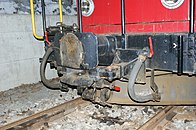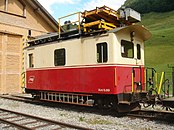SB CFe 2/2
| SB CFe 2/2 | |||
|---|---|---|---|
| Factory photo of the CFe 2/2 3 of the Säntisbahn | |||
| Type designation and numbering: from 1946: Period after 1949: |
CFe 2/2 1 CFe 2/2 37 Ge 2/2 49 Te 2/2 49 |
CFe 2/2 2 CFe 2/2 38 BTB Xe 2/2 202 |
CFe 2/2 3 CFe 2/2 39 Xm 1/2 50 Xm 1/2 51 |
| Manufacturer: |
SWS , MFO |
SWS, MFO, AB |
SWS, MFO, AB, Saurer |
| Construction year: | 1912 | ||
| Modification: | 1955 | - | 1962 |
| Retirement: | - | 1953 | 2014 |
| Axis formula : | B 0 | A 1 | |
| Gauge : | 1000 mm | ||
| Length over buffers: | 11,040 mm | 7650 mm | |
| Total wheelbase: | 4000 mm | ||
| Service mass: | 17.5 t | 12 t | 15 t |
| Friction mass: | 17.5 t | 12 t | 7.5 t |
| Top speed: | 30 km / h | 45 km / h | |
| Hourly output : | 96 kW | 48 kW | |
| Hourly traction: | 11 kN at 30 km / h | 5 kN at 30 km / h | |
| Wheel diameter: | 900 mm | ||
| Installed capacity: | - | 74 kW | |
| Motor type: | - | Sour BLD 1 | |
| Rated speed: | - | 1600 rpm | |
| Power transmission: | - | electric | |
| Power system: | 1000 V = | 1500 V = | - |
| Number of drive motors: | 2 | 1 | |
| Transmission ratio: | 1: 4.5 | ||
| 2nd class seats: 2nd class standing: |
36 20 |
- |
|
The CFe 2/2 were three meter - gauge, two - axle electric multiple units with a third-class and a luggage compartment, which the Säntisbahn (SB) - the later Electric Railway Appenzell – Weissbad – Wasserauen (AWW) - procured for the opening of their valley line Appenzell – Wasserauen in 1912 were.
technical description
The design of the CFe 2/2 1–3 was based on the two-axle tramcars customary at the time . In the middle of the car, however, there was a small luggage compartment in which passengers could stand. The manufacturer of the mechanical part was the Swiss Wagonsfabrik Schlieren (SWS). The air brake came from Westinghouse . Maschinenfabrik Oerlikon (MFO) supplied the electrical part with two traction motors for 1000 volts DC . The starting resistors and the lyre pantograph, which was replaced by a pantograph in 1937 , were on the roof.
commitment
During the week, and especially in winter, the CFe 2/2 drove alone, with the driver also taking over the duties of the conductor . Six two-axle C2 11-16 passenger cars were available for heavier traffic. When tourism increased significantly after the Second World War, the traffic with the three railcars could no longer be handled on beautiful summer weekends. With the three CFe 2/2 and one diesel multiple unit BCFm 2/4 of the Appenzellerbahn, two train compositions were formed, with the multiple units running in double traction .
With the merger of AWW and Appenzeller Bahn (AB) in 1947, the three railcars were given the road numbers 37–39. The Appenzell – Wasserauen line initially had a certain operational life of its own, because the different overhead line voltages of the AWW and AB prevented continuous use of the electric traction vehicles. When in 1949 the voltage of the AWW line was increased to 1500 volts as with the AB, through trains were introduced between Gossau and Wasserauen and the CFe 2/2 was shut down. Railcar 38 came to the Birsigthalbahn , where it fell victim to a depot fire in 1953 as Xe 2/2 202. Parts of the other two railcars were used to build the Ge 2/2 49 locomotive and the Xm 1/2 50 catenary assembly car.
Ge 2/2
The electrical equipment of the CFe 2/2 37 was adapted to the catenary voltage, which was increased to 1500 volts. In 1954 the railcar, which could only travel at 30 km / h, was painted red. After a few test drives, the Appenzeller Bahn shortened the chassis in 1955 and replaced the car body with a central driver's cab with two driver's desks for standing operation. The starting resistors and the compressor are housed in the two stems on both sides of the driver's cab. The Westinghouse brake was a Oerlikon - air brakes replaced. Instead of roof rod couplings , heating cables were installed. The Ge 2/2 49, painted red / cream, was used in freight traffic between Herisau and Urnäsch and occasionally ran winter sports trains from Schwende to Wasserauen. From 1966 she did shunting work as a tractor Te 2/2 49 in Herisau and served in construction work.
After a revision, the locomotive with the original designation Ge 2/2 49 forms a nostalgic train together with the two still preserved C 13 and C 14 passenger cars of the former Säntis Railway.
Xm 1/2
From the CFe 2/2 39, the Herisau workshop built the self-propelled diesel - electric catenary car Xm 1/2 50 in 1962. A new steel car body with two driver's cabs and a storage room was built on the shortened undercarriage. On the roof there is a control pantograph and an assembly platform. The service car of a 100-powered PS - Saurer - diesel engine . One axle was driven. The drive motor, the gearbox, the driving and the running axles came from the CFe 2/2 39.
In 1966 the road number 50 was required for the De 4/4 and the catenary assembly vehicle was given the number 51 and later the number 89. In 2014 the vehicle was broken off.
photos
CFe 2/2 in 1912. In the background HG 2/3 of the ASt, which was used as a construction locomotive
Central buffer coupling of the Te 2/2 49, including + GF + auxiliary coupling
B 282 coupled to Ge 2/2. The feed line (green ) is coupled to the brake line (red) so that the door can close.
Individual evidence
- ^ Yvo Buschauer: The train to Säntis; 100 years of the Appenzell – Wasserauen line; First stage of the planned railway from Appenzell via Meglisalp to the Säntis. Appenzeller Volksfreund, Appenzell 2012, ISBN 978-3-9523858-2-1 , p. 99
- ↑ Buschauer, p. 103
- ↑ Buschauer, p. 111
- ↑ a b c Peter Willen: Locomotives of Switzerland 2 - narrow-gauge traction vehicles. Orell Füssli Verlag, Zurich, 1971, p. 199
- ↑ C13 and C14 of the former Säntisbahn. On the website of the AG 2 Verein historical Appenzeller Bahnen, accessed on January 10, 2019
- ↑ a b c Willen, p. 201
- ↑ a b Ge 2/2 ex Säntisbahn. On the website of the AG 2 Verein historical Appenzeller Bahnen, accessed on January 10, 2019









